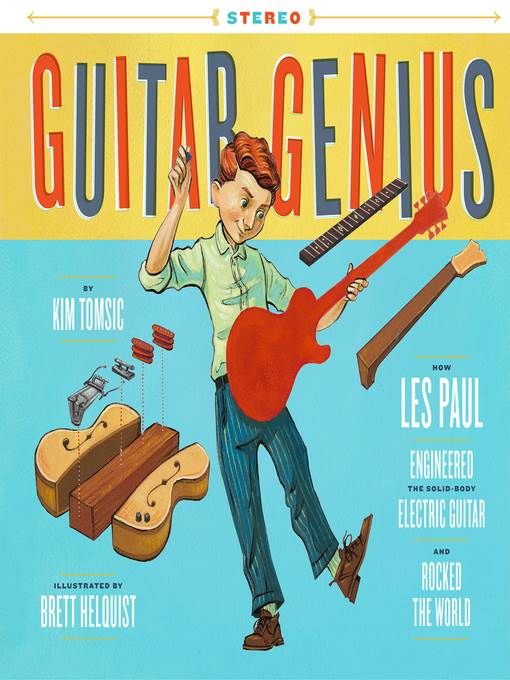
Guitar Genius
How Les Paul Engineered the Solid-Body Electric Guitar and Rocked the World
فرمت کتاب
ebook
تاریخ انتشار
2019
Lexile Score
720
Reading Level
3
ATOS
4.3
Interest Level
K-3(LG)
نویسنده
Brett Helquistناشر
Chronicle Books LLCشابک
9781452180182
کتاب های مرتبط
- اطلاعات
- نقد و بررسی
- دیدگاه کاربران
نقد و بررسی

February 1, 2019
Young Lester Polsfuss' piano teacher sent a note home to Lester's mother saying, "Your boy, Lester, will never learn music, so save your money. Please don't send him for any more lessons." Lester proved her wrong and grew up to become Les Paul, "guitar genius.""You can do anything you put your mind to," Lester's mother told him. So Lester put his mind to creating things: a radio, a recording device, a mic and a speaker, and a solid-body electric guitar that forever changed popular music. Along the way, Lester also created personae--Red Hot Red, Rhubarb Red, the Wizard of Waukesha. As Les Paul, the white man played to diverse crowds with some of the greatest musicians of the era: Louis Armstrong, Art Tatum, Nat King Cole, Coleman Hawkins, and Charlie Christian--all sharing a page in Helquist's illustration as they sometimes shared a stage. The illustrations evoke the musicians' energy with wild flames of sound erupting from speakers and a frequently repeated, sometimes-overdone multicolored circle motif reminiscent of Bryan Collier's circles in John's Secret Dreams (2004). Tomsic effectively explains Les Paul's complex technical achievements, focusing on just a few that make sense for her audience. Her author's note goes into more depth.An exuberant introduction to a musician and creative genius that young readers probably have not heard of before. (Picture book/biography. 6-10)
COPYRIGHT(2019) Kirkus Reviews, ALL RIGHTS RESERVED.

March 1, 2019
Gr 2-5-If your child regularly took apart machines in your home or trimmed down a tread on your stairs to make it sound better, how would you react? Fortunately for musicians and music lovers, Les Paul's mother encouraged, even praised, his efforts. From a young age, Les was curious about sound as it relates to music. His initial attempts to learn to play the piano ended with the teacher declaring, "Lester will never learn music..." but a mail-order guitar and a wooden harmonica proved to be just the ticket to launch his ever-widening curiosity about how to improve the sound so it would reach all the way to the back of crowds that came to hear him play. Each performance venue produced additional problems to solve, leading to more and more tinkering with found objects. His persistence and creativity paid off, as he is credited with numerous inventions that have made today's recorded music possible. Paul's story is delightfully told in folksy, familiar language, with numerous onomatopoeias to represent the sounds he produced. There is additional back matter that adds more detail to illuminate his amazing career accomplishments. Helquist's illustrations, created with colorful oils, are equally delightful and pleasant. Text and illustrations radiate exuberance and joy. Readers will marvel at the perseverance and ingenuity Paul demonstrated throughout his life. VERDICT A strong addition to inspire would-be inventors, and an excellent choice for STEM programs and biography collections.-Maggie Chase, Boise State University, ID
Copyright 2019 School Library Journal, LLC Used with permission.

May 6, 2019
According to his teacher, young Les Paul—who preferred playing piano by ear over sight reading—would “never be musical.” Undeterred and with his mother’s support, Paul pursued his interests, musical and otherwise. After designing and building a radio set, he learned to play guitar, banjo, and harmonica, performing for audiences that expressed their wish to hear the music better. Through trial and error, Paul created contraptions to amplify the sound of his guitar—but the guitar’s vibrations caused unwelcome feedback. A steel rail and an electric guitar prototype (called the Log, because of its shape) led to a design that resembles modern-day instruments. In Helquist’s expressive oil paintings, Paul’s music is visualized as colorful orbs and swirling lines. Good ideas require persistence, determination, and lots of experimentation, Tomsic implies through Paul’s story. A note from the author explores Paul’s contributions to the world of music in greater detail. Ages 5–8.

























دیدگاه کاربران